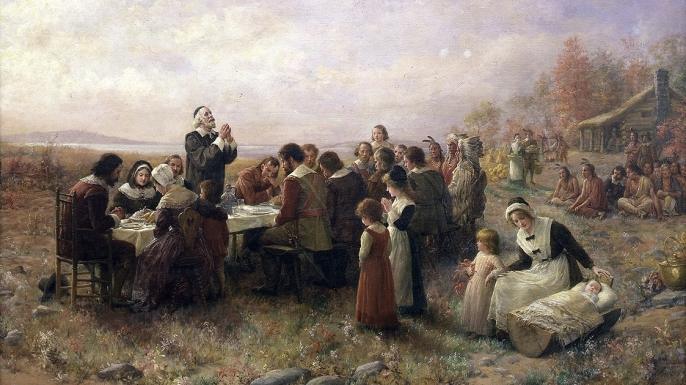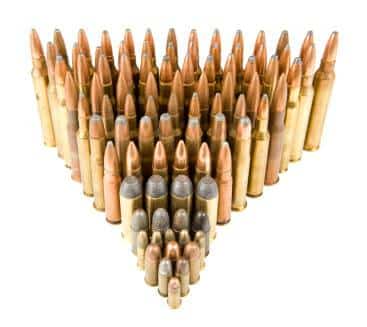The first Thanksgiving – at least, the one involving the Pilgrims — is believed to have occurred over a period of three days, sometime between Sept. 21 and Nov. 9 in 1621.
The feast occurred on a Pilgrim plantation at the Plymouth colony in Massachusetts, and was attended by 53 Pilgrims and 90 Wampanoag Indians. Reportedly, the Pilgrims and the Wampanoag expressed thanks for the animals, fruits and vegetables they were consuming. This is actually a tradition with Native-Americans, who would always thank an animal or plant for surrendering their life so that they may live.
The Pilgrims were grateful to God, not only for the bounty they had collected but for the Wampanoag, who had helped them survive on the brink of starvation and who peacefully co-existed with them for 50 years.
The Pilgrims did not have wood-burning cook stoves. All cooking was done over an open fire, either in cast iron pots and pans, or roasted on spits or suspended next to the fire. Dutch ovens were used for basic baking and braising. There also were some foods cooked in hot ashes, which was a technique they learned from the Wampanoags.
Dependable Solar Generator Provides Emergency Backup Power
Boiling, steaming and frying were the cooking styles of choice, and both duck fat and goose fat were highly prized for a number of dishes. Butter was a scarce and precious commodity, as was milk.
Seasonings were limited, although sea salt and certain herbs like liverwort and some other aromatic herbs like ramps (wild chives) and purslane were used.
What Was Not On The Table

The foods consumed were indigenous or natural to the Massachusetts area in the 1600s. As a result, there were some plants and animals that didn’t show up on the menu:
- Potatoes. There simply were no potatoes growing in North America at that time. No white potatoes, sweet potatoes or red potatoes. Potatoes grew in South America, and it wasn’t until the Spanish brought them to Europe that they eventually made their way to North America.
- Cranberry sauce. Cranberries did, in fact, grow in bogs around Massachusetts, but the sauce we know today was not made. Cranberry sauce requires a lot of sugar, and the Pilgrim’s supply of sugar was nearly exhausted. Honey was too precious for something as basic as a cranberry sauce.
- Dessert. Again, there simply was not enough sugar.
- Turkey. Well, maybe not. (The meat of choice was deer.) Wild turkeys inhabited the region, but other types of fowl took center stage, including ducks, geese, pigeons and even cranes, swans and get this … eagles.
- Bread. At least, not much of it. There were some breads at the table, but mostly sourdough and cornbread. The sourdough was referred to as “cheate” bread by the Pilgrims. The sourdough was baked as a round loaf, probably in a Dutch oven. The cornbread was a gift from the Wampanoag, from a variety of corn referred to as “flint” corn — a yellow corn that was allowed to dry on the plant and was then ground into a flour or corn meal.
- Salt but no pepper. Given the proximity of the Plymouth colony to the ocean, sea salt was in abundance, but pepper was missing in action. Pepper was a very exotic and expensive spice at the time.
What WAS On The Table
So, what did the menu look like? The only foods recorded in history were deer and fowl. In addition, fish, seafood and even seal likely were served. The vegetables tended to be rustic and traditional but very familiar to us. There was fruit, as well as some simple breads.
Let’s have some fun with this and look at the First Thanksgiving in a traditional menu format, with a description of the ingredients and how the dishes were prepared. These were the actual foods served at the First Thanksgiving, with traditional ingredients and a traditional preparation style.
——————————————————————–
Ye Olde Thanksgiving Menu
Appetizers:
Assorted nuts consisting of acorns, walnuts and chestnuts roasted over an open fire in a cast-iron pan and lightly salted with sea salt.
A mix of wild plums and grapes with blueberries, gooseberries and wild black raspberries.
Seal kebobs cut into chunks and slowly roasted on skewers over coals and served with sea salt.
Raw oysters on the half shell served with an herbed vinegar
Surf and surf combination of lobsters and clams boiled in salt water and served with herbed goose fat.
Mussels with curds. The mussels are boiled in sea water, shelled and then mixed with curds until the curds gently melt.
——————————————————————–
Starters:
Vegetable soup
A soup made with sea salt in sea water and a medley of sliced onions, parsnips, carrots, leeks and cabbage and topped with duck fat.
Clam chowder
We start with shucked clams and gently simmer in our limited and precious milk, onions, leeks and then thicken with corn meal and season with sea salt and garnish with chopped spinach leaves.
Mixed green salad
A salad of dandelion greens, plantain leaves, various lettuces, spinach and peas with a dressing made from vinegar and duck fat and a sprinkle of sea salt all topped with chopped liverwort greens.
———————————————————————–
Ye Main Meal
Venison
Venison steaks roasted over an open-fire on a spit and served with a brown-blueberry sauce.
Pan-roasted venison sautéed in a cast iron pan over an open fire with caramelized onions and vinegar.
Braised venison
Cuts of venison from the rump, brisket and shoulders are cut into chunks and flowered in corn meal and then browned in goose fat with onions, carrots and some sea water in a Dutch oven until tender.
———————————————————————–
Fowl
(All fowl dishes are served with an optional stuffing or a “pudding in the belly” made from corn meal, onions, cranberries, herbs, vinegar and sea salt
Pheasant
Spit-roasted pheasant roasted on a spit over open coals and basted with duck fat and sea salt.
Braised goose
Cut-up goose braised with onions, parsnips, carrots and cranberries in a Dutch oven.
Wild turkey
Spit-roasted wild turkey roasted between two beds of hot coals and basted with a sea water, vinegar blend.
Boiled eagle
Cut-up eagle boiled with onions and herbs in a pot of salt water and then quickly seared over open coals.
Pigeons in a pan
Pigeons in a pan with onions and carrots sautéed in a cast iron frying pan in goose fat and duck fat are then topped with roasted and chopped black walnuts.
Hot coal-roasted swan
The swan is set beside a fire vertically on stakes and turned from time to time to cook the meat through. It’s basted with a blend of duck and goose fat and seasoned with sea salt and served whole on a large plank.
——————————————————————-
Fish
Cod
Cod either boiled with onions, roasted over coals or wrapped in grape leaves and simmered in hot ashes.
Sea bass
Whole grilled sea bass basted with duck fat over open coals and topped with sea salt and chopped herbs and spinach.
——————————————————————–
Sides
Stuffed pumpkin
We start by hollowing out a pumpkin and then filling it with chunks of pumpkin, milk, honey and spices and then wrap in boiled grape leaves and cook in ashes until done. It’s served from the pumpkin as a bowl and has the consistency of a custard.
Boiled onions
Onions are peeled, quartered and boiled with raisins, sugar, egg and vinegar until tender.
Squash mash
A variety of squashes from butternut to acorn to pumpkin cut into chunks and boiled until tender and then mashed with honey, cinnamon, cloves and a touch of sea salt.
Mixed vegetables
An assortment of vegetables including carrots, parsnips, onions, spinach, peas, and a blend of chopped herbs all gently boiled and topped with sea salt.
Flint-corn mush
A combination of ground flint corn gently boiled in milk and seasoned with either sea salt or honey.
Boiled spinach
Spinach leaves boiled in sea water and drained and then topped with duck fat and a sprinkle of sea salt.
Your choice of sourdough “cheate” bread or cornbread
——————————————————————-
Dessert
Fruit and nut sampler
A mix of fruits and nuts including grapes, gooseberries, blueberries, wild plums and an assortment of salted and roasted acorns, chestnuts and black walnuts.
———————————————————————–
Beverages
Water
Tea
Maple Sap
———————————————————————
 I don’t know about you, but it all sounds pretty good — although I might take a pass on the boiled eagle. There’s a hefty fine and they are never in season these days.
I don’t know about you, but it all sounds pretty good — although I might take a pass on the boiled eagle. There’s a hefty fine and they are never in season these days.
If you want to try one of these recipes, the menu is pretty self-explanatory with ingredients and cooking style. This was a very rustic, simple and direct type of cooking. There were no meat thermometers to tell you when something was done; the usual shake on the drumstick of any bird would tell you it’s done when it feels loose and the juices run clear.
Fish was easy enough to evaluate when the fish was opaque and flaked, and most boiling and braising methods would indicate doneness with a simple slice and a taste.
You may or may not want to toss one of these recipes on your Thanksgiving table, but even if you don’t, you can always throw a cold plate of plums, grapes and berries out there to remember that first Thanksgiving.









